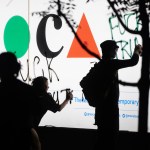There was a time when county government followed Quaker principles in how to design a prison. Completed in 1884, the lockup on Pine Street in Doylestown was distinctive for 40 tiny, windowless cells. Prisoners had to stoop to enter (a sign of Quaker humility), serve their solitary sentences while seeking redemption. Though widely praised at the time, long duration solitary imprisonment to me and many others is considered excessively cruel, unlikely to achieve any positive results.
The euphemistic “Pine Street Hotel” closed in 1985 and transformed into today’s esteemed James A. Michener Art Museum. A flashback to the museum’s prison history is the core of an exhibition coming in the spring. Funded by a $184,580 grant from the Pew Center for Arts & Heritage, “Behind These Walls: Reckoning with Incarceration” is intended to raise public awareness of the inhumanity of solitary imprisonment.

Laura Igoe, the Michener’s Gerry and Marguerite Lenfest chief curator, and others at the fine arts center have yearned for a way to present the museum’s previous history through art.
“We don’t have a good interpretation of the museum’s previous history as a prison,” Laura told me. “We have two exhibitions on sculpture and monuments for 2024. We got to wondering what a monument to our site as a prison would look like?”
More:Explore the 5 castles of Bucks County, and a bonus castle nearby
That led to New Orleans-based artist jackie sumell. Her “solitary garden” sculptures seemed ideal for the Michener. Raised gardens built to the size of a U.S. solitary cell are “gardened” by prisoners through correspondence.
Serendipity put jackie on the path to her life’s work. The Brooklyn native was a grad student at Stanford University in California 20 years ago when she was invited to a lecture organized by someone she had a crush on. She was riding her bicycle to the event when a car cut her off. “I remember getting off my bicycle and I was screaming profanities, and I was so angry,” jackie explained. “And then I went into this lecture, and I had no idea what it was going to be about. This man sat in front of me who had just spent 29 years in solitary confinement for a crime he didn’t commit, and he had no visible anger. And I was like, ‘I have something to learn from him.’ And when I asked him what I could do, he said ‘Write my comrades.’”

For 12 years she corresponded with lecturer Robert King and pals Herman Wallace and Albert Woodfox, both in isolation 23 hours daily in Louisiana. All three were Black Panther activists known as the Angola 3 who were arrested in the early 1970s. During their imprisonment, they were falsely accused of murdering a prison guard and sentenced to life in solitary.
In her letters, jackie asked Wallace to visualize his ideal home. That correspondence led to a PBS documentary “Herman’s House” gaining jackie international recognition. In subsequent years, she conceived a new project involving raised garden beds, 6 feet wide and 9 feet long. That’s the size and footprint of a typical solitary confinement cell in American prisons. The idea was getting “solitary gardeners” to decide what to grow in each garden via correspondence. Each bed would exist for three growing seasons before dying out. To jackie, the gardens would be a metaphor. As she told a New Orleans newspaper, “The 16-year-old who was arrested is a different person having spent decades in prison. Organic materials (in the gardens) change over time, and they transform, like human beings.”
More:Lower Makefield unveils big plans for Patterson farm makeover
The artist will collaborate with volunteers to grow the Michener’s “solitary garden” through correspondence with an incarcerated person. This fall and winter, an advisory committee drawn from the community will decide where the garden will go and determine the content and presentation of a historical overview of the local jail before it became a museum. It will be freely accessible to the public as part of the museum’s 35th anniversary as a cultural hub of Bucks County.


Sources include “The Legacy of Herman Wallace, And the Movement to End Long-Term Solitary Confinements” published in All Things New Orleans on Oct. 28, 2013, and “Art garden protesting solitary confinement conditionals dedicated” published by the Times-Picayune newspaper on Sept. 20, 2016.
Carl LaVO can be reached atcarllavo0@gmail.com
This post was originally published on this site be sure to check out more of their content.




